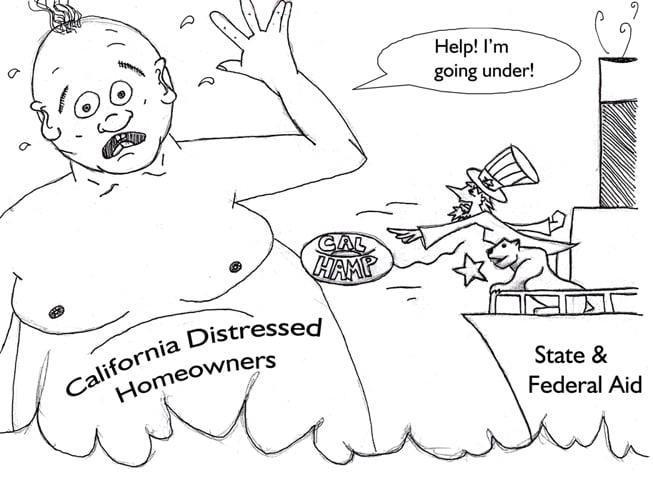Less than one million homeowners have received assistance under the Home Affordable Modification Program (HAMP), six years after its creation. HAMP is a federal modification program originally intended to aid four million struggling homeowners. It was launched in the fallout of the decimated Millennium Boom and continues to limp along today.
HAMP stalled at inception and is still plagued with problems, according to a report by Christy L. Romero from the Office of the Special Inspector General for the Troubled Asset Relief Program (TARP).
HAMP attempted to offer aid to homeowners struggling to pay their mortgages and avoid foreclosure by lowering their monthly mortgage payments to sustainable levels.
Mortgage holders receive monetary incentives to boost their willingness to modify mortgages for struggling homeowners. Mortgage holders modify mortgages by:
- lowering the interest rate;
- extending the term of the mortgage;
- forgiving part of the principal amount; or
- a combination of any of the above procedures.
To be eligible for HAMP, homeowners need to be:
- struggling to make monthly mortgage payments;
- in danger of falling behind on their mortgage payments; and
- able to make the modified mortgage payments if the modification becomes permanent.
Eligible homeowners are placed into a trial period plan (TPP) which lasts between three to four months. During the TPP, homeowners must show they can make the new monthly mortgage payments. After a successful trial, a permanent modification is entered into.
However, 72% of homeowners’ HAMP applications were denied by the mortgage holders who owned the loans. The mortgage holders accusingly point their fingers at homeowners, blaming the low HAMP adoption rate on homeowners’ failure to complete paperwork or make the first modified payment under the TPP.
The report by Romero reveals the trouble lies not with the homeowners, but the mortgage holders. The report states HAMP’s two biggest flaws are:
- voluntary participation in the program by mortgage holders; and
- lack of mortgage holder supervision by a third party.
HAMP claims many mortgage holders around the country are actively participating. But, as the report discovers, the mortgage holders are not always playing by the rules, baiting homeowners into an “extend and pretend” situation.
Thus, homeowners are forced to chug along and comply with anything mortgage holders ask them to do in the hopes of getting a permanent mortgage modification — or hire an attorney who will help them fight back.
Homeowners’ HAMP horror stories
For many homeowners, applying for HAMP is a nightmare. Homeowners report troubles such as the failure of mortgage holders to:
- locate and retain the required mortgage documents properly submitted by homeowners;
- keep accurate records of homeowners’ information;
- process paperwork in a timely fashion; and
- give homeowners an accurate report on the status of their application.
Homeowners’ horror stories often include being dragged slowly through the process by mortgage holders who repeatedly lose submitted documentation. These homeowners then face countless processing obstacles, only to end up losing their homes or re-defaulting on their mortgages.
Even when homeowners have completed their TPP, they are frequently denied a permanent modification. Supplemental Directive 9-01 sets the standards and guidelines for HAMP, but mortgage holders are clearly not following them. When many mortgage holders are not following the guidelines, homeowners are left without the aid they seek and the very intent of the program is negated.
However, homeowners are fighting back against mortgage holders’ misconduct by taking them to court.
In recent court cases, mortgage holders attempt to dodge granting a permanent modification by:
- conveniently forgetting to sign and return required documents;
- incorrectly claiming that HAMP only obligates them to reevaluate homeowners’ eligibility after they complete a TPP; and
- falsely concluding the TPP was not a binding contract requiring them to grant a permanent modification.
The courts ruled in favor of the homeowners in each of these cases. So, while mortgage holders are not getting away with their misconduct, it takes a lot more to right their wrongs than these ordinary homeowners ever could have expected.
Not enough incentive for mortgage holders to help
Why aren’t mortgage holders performing? The incentives are simply not large enough to encourage them to step up to the plate. Incentives for mortgage holders participating in HAMP range from $400-$1,600 per permanent modification granted, and may include an additional $1,000 for three years if the monthly mortgage payment is reduced by 6% or more. This remuneration is not enough to compel mortgage holders to train employees on the proper handling of HAMP or induce them to help homeowners out from under their excessive mortgage payments.
As frustrating as it is for homeowners, mortgage holders are profiting from delays (and eventual foreclosures). The delays in granting homeowners a permanent modification means mortgage holders extend the period of time in which they may collect fees and interest.
But when mortgage holders are making more money NOT helping homeowners than helping, they drag their feet as a matter of innate lender hardwiring. Thus, when mortgage holder participation in the program is discretionary, mortgage holders naturally react in a manner that most benefits them, not the beleaguered homeowners as the program intended.
No supervision inevitably leads to lender misconduct
With only minimal government supervision, mortgage holders are free to act for solely selfish ends. Lost documents, inaccurate information about homeowners, insufficient staff, countless obstacles, even denying eligible homeowners are all part of the norm when mortgage holders are playing their own game by governing themselves.
Furthermore, the relationship between mortgage holders and homeowners is historically adversarial. Without policing from a neutral third party, such as the courts or a government agency, homeowners receive no protection from mortgage holders’ misconduct and no assistance from the program designed to provide just that. After protracted delays, homeowners are frequently left worse off than before they started the program.
While the intentions behind HAMP were admirable and aimed at aiding struggling homeowners, it had no internal remedy. It gave homeowners the promise of help, but ultimately, it proved to be more trouble for homeowners than it is worth.
Re: “A Slack Lifeline for Drowning Homeowners” by The New York Times
















The banks deal better with another entity. I know people who are underwater but won’t try to modify their loan. One person is paying 6 percent interest I suggested he at least refi the loan and save some interest. Some people just walk away. I tried to buy a short sale a different person at the bank every time not the same person. Then one of the many different people decided the seller should give them a $15000. promissory note or I should. I canceled my offer. This bank had already agreed to another short sale with the same seller on the same street identical building it was a Florida Bank for a CA loan. Too bad about the gal that missed her payments on the bank’s advice.
As a CA real estate agent for 35 years, a home owner for over 46 years, and a landlord for nearly 10 years. it grieves me to say and admit, that I was a victim, and a loser, due to the modification program. I owned a 4-plex, next to a college, using my retirement funds and a 1031 tax free exchange to acquire the complex. When the crunch began, my tenants lost their jobs, their parents lost their jobs, and I had very little rents coming in or none at all. Yet, I continued to make the payments…in all my years, I never had a late payment on a mortgage. After requesting a minor $200 a month reduction on my payment for 6 months and being turned down every month, I was told finally that the turn down was because I was current on the payments. I was informed that I had to be behind in my payment in order for them to consider my request. So, after a couple months more of struggling, and my husband losing his job too, I had no other choice but to miss payment on that BofA loan. (my other 3 mortgages –primary home and 2 other rentals) were and are today still current). After missing 2 payments, all hell broke loose—-my credit lines were cut down to what I owed on the balances, my American Express card cancelled my card after 33 years of perfect payments of $0 balances each month, even Sears cancelled my account, I hired a company to handle the modification for me, asking for a reduction of interest rate only….That cost me $3000. I saved all the received rent in order to help make my payments when I received the modification. After 9 months, and turn downs, and hiring an attorney for $1200, I was turned down again…and the foreclosure was being put through in 4 days. I was told I could re-instate the loan by making up the back payments, So I borrowed $10000 from my sister and paid the back payments….but they also required I pay an additional $9000 for their foreclosure fees and their attorney fees. I couldn’t do it..it made no sense to me and all I had built up in credit was totally destroyed, so I put the complex for sale as a short sale. Well, it didn’t end there….the right hand didn’t acknowledge what the left hand was doing, despite the fact they were sent the sale contract 3 times. The bank foreclosed on me, October 2011, told the tenants lies, (new ones who were paying rent), kicked them out without giving them legal notices to vacate, told them I had lied to them all along about there was really no short sale or buyer, and the short sale buyer was out too, The short sale would have given BofA more money, saved my credit to a degree, allowed the tenants to remain in the complex, and the buyer would have paid for the new air conditioners that were installed. Instead I had to pay for them, and BofA didn’t sell the complex until nearly 2 years later–funny, the same buyer got it for another $50000 less! My credit is still in the dump and I am planning eagerly for my retirement when I am 94 years old!! Oh, I had to pay the IRS on the money used for the 1031 xchng too!!!!!!!!!!!!! The lenders are criminals and should all be in jail……they knew exactly what they were doing to the general public and they got away with it all. It is clear that they triple dipped –they received tarp money, they wrote off the loss on their loans, they foreclosed on the loans and then resold the properties….those poor, poor, banks, ………….!!
I found that the major banks, like JPMorgan Chase repeatedly asked me for the same documents OVER AND OVER again only to deny me a modification. I was on disability and could prove a financial hardship from previous years. On my 4th attempt, I hired a firm in SoCal to assist. Within 90 days (per requirements), I had my HAMP loan and I could not be happier. My interest rate is 2% for first five year, to increase to 2.5% in 6th year and 3% MAX in 11th year (at which time my home will be paid for), my incentive is every April, $1,000 taken off loan principle for first 5 years, 6th year an additional $5,000 in a lump sum removed – AND, $199K was DEFERRED from my principle. I COULD NOT BE HAPPIER! LOVE HAMP and the Lender who took it one finally (SP Servicing).
Angela, check Your deferred amount to make sure it adds up with your principal balance, and reflect the original loan balance before the mod.
This article is quite accurate. As an attorney-broker who has been active in these cases for many years, the misconduct by lenders and servicers has been outrageous. Fortunately, in California, as of 2013 we have the Homeowner Bill of Rights, which provides strong and effective protection for borrowers, including requiring servicers to pay attorney fees for prevailing borrowers in many cases. Nevertheless, the deliberate sabotage of the modification process continues, as the servicers know that 90-95% of borrowers will not fight.
True. I am in California – and I am a FIGHTER!